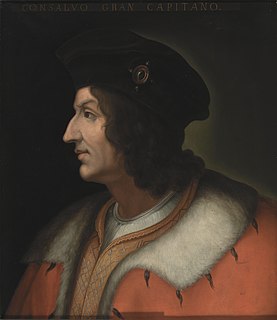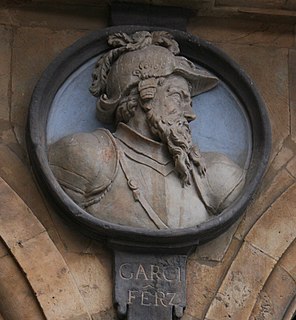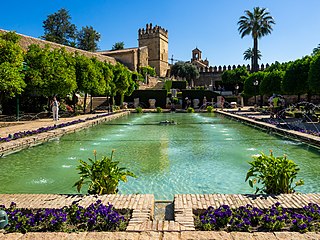
Córdoba, also spelled Cordova in English, is a city in Andalusia, southern Spain, and the capital of the province of Córdoba. It is the largest city in the province, 3rd largest in Andalusia, after Sevilla and Málaga, and the 12th largest in Spain. It was a Roman settlement, taken over by the Visigoths, followed by the Muslim conquests in the eighth century and later becoming the capital of the Caliphate of Córdoba. The city served as the capital in exile of the Umayyad Caliphate and various other emirates. During these Muslim periods, Córdoba was transformed into a world leading center of education and learning, producing notable figures such as Averroes, Ibn Hazm, and Al-Zahrawi, and by the 10th century it had grown to be the second-largest city in Europe. It was conquered by the Kingdom of Castile through the Christian Reconquista in 1236.

San Lorenzo de El Escorial, also known as El Escorial de Arriba is a town and municipality in the Community of Madrid, Spain, located to the northwest of the region in the southeastern side of the Sierra de Guadarrama, at the foot of Mount Abantos and Las Machotas, 47 kilometres (29 mi) from Madrid. It is head of the eponymous judicial party. The settlement is popularly called El Escorial de Arriba, to differentiate it from the neighbouring village of El Escorial, also known as El Escorial de Abajo.

An alcázar is a type of Moorish castle or palace in Spain and Portugal built during Muslim rule although the term is also used for many medieval castles built by Christians on earlier Roman, Visigothic or Moorish fortifications. Most of the alcázars were built between the 8th and 15th centuries. Many cities in Spain have an alcázar. The term is frequently used as a synonym for castillo or castle; palaces built by Christian rulers were also often called alcázars.

Gonzalo Fernández de Córdoba y Enríquez de Aguilar, 1st Duke of Santángelo was a Spanish general and statesman who led successful military campaigns during the Conquest of Granada and the Italian Wars. His military victories and widespread popularity earned him the nickname "El Gran Capitán". He also negotiated the final surrender of Granada and later served as Viceroy of Naples. Gonzalo was a masterful military strategist and tactician. He was the first to introduce the successful use of firearms on the battlefield and he reorganized his infantry to include pikes and firearms in effective defensive and offensive formations. The changes implemented by Gonzalo were instrumental in making the Spanish army the dominant force in Europe for more than a hundred years. For his extensive political and military success, he was made Duke of Santángelo (1497), Terranova (1502), Andría, Montalto and Sessa (1507).

Maria of Portugal was a Portuguese princess who became Queen of Castile upon her marriage to Alfonso XI in 1328. She was the first daughter of King Afonso IV of Portugal and his first wife Beatrice of Castile.

The Mosque–Cathedral of Córdoba, officially known by its ecclesiastical name, the Cathedral of Our Lady of the Assumption is the cathedral of the Roman Catholic Diocese of Córdoba dedicated to the Assumption of Mary and located in the Spanish region of Andalusia. Due to its status as a former Islamic place of worship, it is also known as the Great Mosque of Córdoba, or the Mezquita. The structure is regarded as one of the most accomplished monuments of Moorish architecture built by the European Moors.

Sancho Garcés II, also known as Sancho II, was King of Pamplona and Count of Aragon from 970 until his death in 994. He was the eldest son of García Sánchez I of Pamplona and Andregoto Galíndez. He recognised the Kingdom of Viguera during his reign.
Íñigo Arista was a Basque leader, considered the first King of Pamplona. He is thought to have risen to prominence after the defeat of local Frankish partisans at the Battle of Pancorbo in 816, and his rule is usually dated from shortly after the defeat of a Carolingian army in 824.
The Martyrs of Córdoba were forty-eight Christian martyrs who were executed under the rule of Muslim conquerors in what is now southern Spain. At the time the area was known as Al-Andalus. The hagiography describes in detail the executions of the martyrs for capital violations of Islamic law, including apostasy and blasphemy. The martyrdoms related by Eulogius took place between 851 and 859.
García Sánchez II, was King of Pamplona and Count of Aragon from 994 until his death c. 1000. He was the eldest son of Sancho II of Pamplona and Urraca Fernández and the second Pamplonese monarch to also hold the title of count of Aragon. Modern historians refer to him as the Tremulous, though this appellation likely originally applied to his grandfather, García Sánchez I of Pamplona.

Constance of Portugal, was Queen of Castile by her marriage to Ferdinand IV.

García Fernández, called of the White Hands, was the count of Castile and Alava from 970 to 995. In May 995, he was captured by a raiding party while out hunting. Wounded in the encounter, he was sent to Cordoba as a trophy, but died at Medinaceli in June 995.
Sancho García, called of the Good Laws, was the count of Castile and Álava from 995 to his death.

The Alcázar de los Reyes Cristianos, also known as the Alcázar of Córdoba, is a medieval alcázar located in the historic centre of Córdoba, next to the Guadalquivir River and near the Grand Mosque. The fortress served as one of the primary residences of Isabella I of Castile and Ferdinand II of Aragon.

Saint Eulogius of Córdoba (Spanish: San Eulogio de Córdoba was one of the Martyrs of Córdoba. He flourished during the reigns of the Cordovan emirs Abd-er-Rahman II and Muhammad I.
Cristóbal de Vera (1577–1621) was a Spanish painter.

The Royal Monastery of St. Jerome is a Roman Catholic Hieronymite monastery in Granada, Spain. Architecturally, it is in the Renaissance style. The church, famous for its architecture, was the first in the world consecrated to the Immaculate Conception of Mary.
Monasteries in Spain have a rich artistic and cultural tradition, and serve as testament to Spain's religious history and political-military history, from the Visigothic Period to the Middle Ages. The monasteries played an important role in the recruitment conducted by Christian aristocracy during and after the progress of the Reconquista, with the consequent decline in the Muslim south of the peninsula.

Mariana Fernández de Córdoba y Ayala, also known as Mariana de Ayala Córdoba y Toledo, was the fourth Lady of Casarrubios del Monte in the province of Toledo. She was the daughter of Diego Fernández de Córdoba y Carrillo, first Lord of Baena, and Inés Ayala y Toledo, third Lady of Casarrubios del Monte.
The Alcázar of the Caliphs or Caliphal Alcázar, also known as the Umayyad Alcázar and the Andalusian Alcazar of Cordoba, was a fortress-palace (alcázar) located in Córdoba, in present-day Spain. It was the seat of the government of Al-Andalus and the residence of the emirs and caliphs of Córdoba from the 8th century until the 11th century and the residence of local Muslim governors from the 11th century until the Christian conquest in 1236. The site was composed of heterogeneous constructions ranging from the private residences of the rulers and their households to the government offices and administrative areas. Today, only minor remains of the palace have survived, including the Caliphal Baths which have been converted into a museum. The rest of the site is occupied by later structures including the Alcázar de los Reyes Cristianos, the Episcopal Palace, the Seminary of San Pelagio, and the Campo Santos de los Mártires public square.












